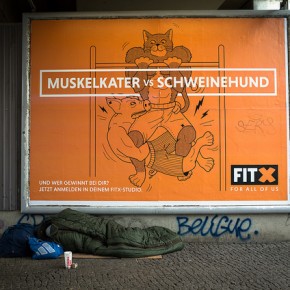It is (currently) illegal in Germany to call Jürgen Elsässer an anti-Semite, and by all accounts, he has very good lawyers. This article merely suggests that articles published in his magazine utilize components of anti-Semitic rhetoric. About what he is or isn’t, the reader is invited to make up her own mind.
It may very well be that in 30 years, people will point to our time as the moment when the European far right was reborn. All over the continent, nationalist populism is growing in strength. Reactionary politics are adapting to a changed cultural and political ecosystem. Old weights are being thrown off, and old ideas provided with a new face.
Instead of a hierarchy of races, fascists now talk of the value of distinct cultures. Instead of celebrating a particularist national chauvinism, they unite under the banner of European identity. And when they speak of Islam as an alien, menacing force, they often adopt the familiar vernacular of post 9/11 neoconservatism: it’s not “Blut und Boten” that needs to be defended, but our “Judeo-Christian identity.”
The abandonment of open anti-Semitism may be the best yardstick by which to measure this drive for a modernized far-right. Sincere or not, today’s neo-reactionaries have long understood that few things will disqualify them as effectively from entering the mainstream of society than anti-Semitism. Islamophobia often helps them take this leap: Geert Wilders, for example, hates immigrants, but he loves Israel. And Marine Le Pen first had to disown her father’s explicit racism and his flirtations with Holocaust-denial before she could transform his party into the major political force it is today.
In Germany and Austria, a new generation of extreme rightists has made a conscious decision to distance itself from even the most qualified identification with historical Nazism. The goal is to give ultra-nationalism a fresh start, and to make it amenable to a larger audience. But anti-Semitism is not incidental to anti-liberal European nationalism. It is a central part of it. It is probably no coincidence that in Hungary, a beacon of hope for nationalists all over Europe, anti-Semitism is, in fact, growing parallel to the strength of nationalist parties. Antisemitism may be repressed and it may be excised from official proclamations, but it will just as often resurface, even if it does so in new and modified forms.
As more and more people feel helpless in the face of a globalized capitalism, and disempowered by supra-national structures of governance, conspiracy theories about the secret masterplans of a shady, globalist elite have captured the imagination of millions. In these visions, faceless and parasitical financial elites are using the banking system to subjugate entire productive economies, while at the same time aiming to establish a globalized world government. The only bulwark against this agenda are independent, sovereign nation states with a strong sense of cultural identity, which alone can resist subjugation by the global power structure.

Like most conspiracy theories, this belief in the “New World Order” is so effective because it taps into a widespread dissatisfaction with the realities of global neoliberalism, and formulates a sense of dispossession and disempowerement in the face of global capital. It is merely the literalized form of a more diffuse defensive nationalism that is defining our historical moment. It is no surprise that these sentiments have spread after the financial crisis, and that they are most strongly rooted among the relative losers of our new world order, most obviously in the formerly communist countries like Hungary, Russia, Poland, or Eastern Germany. The question is: Can there be, in Europe, a politics of nationalist liberation building on a vague opposition to global capitalism that does not ultimately zero in on that oldest of enemies, “world Jewry”?
I was thinking about this as I was waiting for a train one evening in Leipzig. A nearby anti-immigrant protest had just ended, and under the watchful eyes of the police protesters were filing into the train station, where they bought beers or (ironically) ate at McDonald’s before joining me on the platform. They were either young, bull-necked thuggish types, or elderly people with little else to do on a Friday night than stand in the rain and chant slogans against the government.
At the protest, I would later find out, one speaker had urged the right-thinking majority to finally get out its “pitchforks” and “beat out the treasonous elites from the parliaments, the courts, the churches, and the press-houses.” At the same time, while the police was distracted with keeping protest and counter-protest apart, on the other side of town, a group of 250 fascists had seized the opportunity and attacked and destroyed stores and restaurants in a traditionally left-wing neighbourhood. The atmosphere that evening was filled with anger and aggression.
In other words, it wasn’t a pleasant scene on that train platform, which is why I decided to go look at some magazines until the train arrived. It was then that I discovered the following article, written by Marc Dassen. It was published in Compact, a fringe political magazine, the circulation of which, however, has exploded in recent months as it transformed itself into the voice of the nationalist anti-establishment movement, particularly in the East of Germany. One of its front covers, featuring a picture of Angela Merkel wearing a hijab, has become a central icon of anti-immigrant protests like PEGIDA.
Compact’s founder, Jürgen Elsässer, is lie the Glenn Beck of Germany: a true believer on the one hand, but also a huckster and a con man who latches on to popular sentiments and sells apocalyptic populism to a confused and angry public looking to somebody to reveal “the truth” to them. He started out as a left-wing radical, and used to be a strong critic of precisely the kind of nationalist, anti-Western anti-capitalism that has now become his trademark.

In the early 1990s, he was one of the original protagonists of what later would become known as the “Anti-German Left”. After many years as a journalist and radical politico, however, he transformed himself into a self-declared “National Bolshevist“, and grew estranged from his former allies. In 2008, he attempted to capture the angry mood after the financial crisis with his “initiative against finance capital”, a series of protests which already employed a rhetoric with strong anti-Semitic overtones. When he founded his magazine a few years later, he combined a purportedly “neither left nor right” nationalism with a penchant for dramatic anti-American, anti-capitalist conspiracy-talk.
The Ukraine-crisis helped Elsässer to attract the pro-Putin demographic, but it was really the refugee crisis that put his magazine over the top and helped him grow his alternative media empire. In recent years, Elsässer has been constantly moving further to the right, recently even granting a long interview to Karl-Heinz Hoffmann, former leader of one of the largest and most dangerous neo-Nazi underground armies in the 1970s and 1980s, the Wehrsportgruppe Hoffmann. With ordinary print magazines struggling to get by, Compact has not only established itself, but, by its own account, is gaining thousands of readers every month.
Ironically, nothing could have prepared Elsässer better for the role of a neo-nationalist demagogue than his years as a member of the radical left. He has a deep understanding of the inner logic of nationalist ideology, which, after all, he used to oppose and criticize for years, and he knows how to create the effects of anti-Semitism without ever becoming too explicit. Codewords such as “international financial oligarchy”, and his willingness to sue anybody who dares calling him an anti-Semite, have long protected his reputation.
“Why”, he asked mischievously at a protest a few years ago, “is it antisemitic to say that a small financial aristocracy is using the Federal Reserve to throw the entire world into chaos?” Yes, why indeed. Elsässer himself of course knows the answer perfectly well, even though many of his followers may lack the historical knowledge or political sophistication to understand clearly what ideas he is evoking.

Recently, Elsässer declared furiously that “Washington, Brussels, Ankara, and Tel Aviv do not have the right to prohibit us [the German people] democracy.” When a court prohibited the activist and writer Jutta Ditfurth to call Elsässer an anti-Semite last year, the decision caused widespread outrage and disbelief (see this report in English in the Jerusalem Post.)
The article in question appears in a section of the magazine which promises to uncover the “masterminds” behind the refugee crisis. The headline says: “The Invisible Hand: It is High Finance that deals the hands in the refugee crisis. As always when it comes to matters of destabilization and colour revolutions, Mega-Speculator George Soros is involved. But he is not the only one.”
The author writes: “Could Refugee-Promotion [programs meant to entice refugees to come to Europe] be centrally organized? Hungarian Prime-Minister Victor Orbán believes this to be the case: ‘This invasion is directed by the smugglers on the one hand, and on the other hand by activists who will support anything that weakens the nation state’, he told the newspaper Die Welt.”
The article goes on to describe the work of a Soros-funded NGO, which supports refugees on their journey, but it suggests that this work is not driven by humanitarian, but rather by other, sinister motivations. The true goal of these “activists”, the author suggests, is to transform our societies. The article goes on to outline this secret agenda:
“The British Daily Express in October 2008 described a ‘secret plan to let 50 Million Africans into the EU’. […] Similiar numbers are put forth by the US-Geostrategist Thomas P.M. Barnett […] Already in 2004 he demanded that Europe accept 1,5 mio. immigrants yearly until 2050. To justify this migration-political shock therapy, Barnett refers to a report published in 2000 by the UN-Department for Demographical Development, [which] […] called for “Replacement Migration” to prevent demographic decline in Europe.
This corresponds to what the anti-immigrant movement [he is referring to the radical right Generation Identitaire, which has its German and Austrian counterparts] calls the ‘Great Replacement’, and which Richard Nikolaus Coudenhove-Kalergi (1894-1972) welcomed as the coming Pan-Europe. In his book, Practical Idealism, published in 1925, the son of an Austrian ambassador wrote: “The European-Negroid future race, in its physical appearance resembling the old people of Egypt, will replace the diversity of the people with a diversity of personalities.”
So there you go: Anti-American resentments, signs of German paranoia, and a few cherry-picked quotes, all artfully assembled in a tabloid style, suggesting (but not outright claiming!) that there is a global conspiracy to attack European sovereignty and fulfill a generation-old masterplan of racial miscegenation. For those readers who haven’t got the hint yet, there is a little box of text to the right of the article, which I will translate in full:
“What is driving Soros’ only seemingly selfless engagement for ‘open societies’ has been described by Krisztina Koenen in the FAZ-magazine on July, 20th, 1990: ”Whether anti-Semitism will grow stronger or disappear one day, depends on whether the idea of an open society will triumph or fail’, Soros said in conversation to Koenen. ‘Jews are eternal strangers, they remained ‘foreigners’ in every society. But in systems which are able to integrate foreign elements, Jews can attain a prominent position.’ With these words the ‘staunch egoist’ Soros may have already been thinking of himself and his ‘philantropic operations.'” (my emphasis)
That clears it up: Soros, the mastermind, and his “only seemingly selfless” agenda … won’t those devious, shifty Jews ever let us live in peace?!?
Photographs courtesy of the OECD and Frank Kopperschläger. Published under a Creative Commons license.





